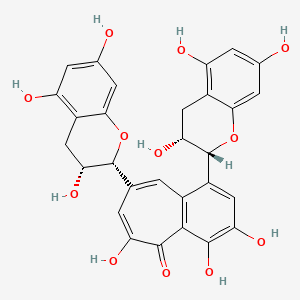| ImmunCR Id : | ICR150 |
| Chemical Name : | Theaflavine |
| Plant Source : | Black and oolong teas |
| Nutraceutical information : | Edible, High content found in black tea |
| Mode of administration : | Oral |

| Immunomodulatory mechanism : | Theaflavin prevents LPS-induced IL-6, MCP-1, and ICAM-1 expression through blockade of NF-κB and MAPK signaling pathways in bone marrow-derived macrophages |
| Description : | Theaflavin is a biflavonoid that is 3,4,5-trihydroxybenzocyclohepten-6-one which is substituted at positions 1 and 8 by (2R,3R)-3,5,7-trihydroxy-3,4-dihydro-2H-chromen-2-yl groups. It is the main red pigment in black tea. It has a role as an antioxidant, a chelator, a plant metabolite, a radiation protective agent and an antibacterial agent. It is a polyphenol and a biflavonoid. |
| IUPAC Name | 3,4,6-trihydroxy-1,8-bis[(2R,3R)-3,5,7-trihydroxy-3,4-dihydro-2H-chromen-2-yl]benzo[7]annulen-5-one |
| SMILES | C1[C@H]([C@H](OC2=CC(=CC(=C21)O)O)C3=CC4=C(C(=C(C=C4[C@@H]5[C@@H](CC6=C(C=C(C=C6O5)O)O)O)O)O)C(=O)C(=C3)O)O |
| Formula | C29H24O12 |
| InchiKey | IPMYMEWFZKHGAX-ZKSIBHASSA-N |
| Kingdom | Phenylpropanoids and polyketides |
| Superclass | Flavonoids |
| Class | Flavans |
| Subclass | Flavan-3-ols |
| LogP | 2.629 |
| Molecular weight | 564.494 |
| Hydrogen Bond Acceptor | 12 |
| Hydrogen Bond Donor | 9 |
| Polar surface area | 222.5 |
| No. of rotatable bonds | 2 |
| Number of Aromatic Rings | 3 |
| Number of rings | 6 |
| Absorption level | Very low |
| Solubility level | Very Soluble |
| Blood Brain Barrier | Undefined |
| Plasma protein binding | Non-Binder |
| CYP2D6 inhibition | Non-Inhibitor |